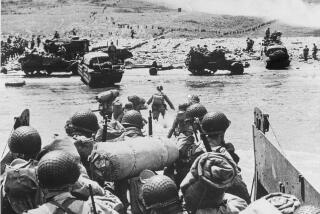Exploring D-Day From the British Side
- Share via
LONDON — The rain didn’t slow my son Matt down a bit. He was too busy playing World War II, clambering up and down the huge battle cruiser’s seven decks, inspecting the six-inch gun turret, imagining himself in command on the bridge.
“I bet it was cool to fight on this ship,” he decided after we listened to a simulated battle, complete with flashing lights, sirens and gun fire.
We were aboard the HMS Belfast, one of the largest cruisers ever built for the British Royal Navy and now Europe’s last surviving World War II warship. On D-day she was among the first to open fire on the Germans in Normandy, France.
Now permanently anchored in the Pool of London near London Bridge and the Tower of London, she’s part of the Imperial War Museum and is visited by thousands each year, including many school children who inspect the galley and sick bay, the boilers and engines--everything it took to carry a ship with 850 men into battle.
Like many other World War II sites, the Belfast is gearing up for an influx of visitors this year because of the 50th anniversary of the D-day invasion, which signaled the beginning of the end of the war. It’s an excellent time to give children a dose of World War II history with a visit to Britain.
“This is a way to share history with the generation that experienced it,” said Helena Koenig, about children taking such a trip with their grandparents. Koenig is founder of GrandTravel, a Maryland-based travel agency that specializes in grandparent-grandchildren trips, and this summer her company is offering a special 15-day “Dover to Calais--World War II Remembered” trip, with stops at Omaha Beach and Gen. Dwight D. Eisenhower’s D-day headquarters, as well as visits to Paris and London. (Land portion of the tour is more than $4,000 a person. Call 800-247-7651 for a brochure.)
In the months before the invasion, thousands of American troops were stationed in southern England for training. To welcome them and their families, hundreds of special exhibits and celebrations are planned--from official commemorative events the week of D-day in June, to local parties at pubs, to museum offerings. The D-day Museum and Overlord Tapestry in Portsmouth, on the English Channel, is the only museum in Britain devoted to D-day. North of Portsmouth is Southwick House, where Eisenhower made the decision to go ahead with the invasion. In London, the Imperial War Museum has mounted an extensive “D-day to Victory” exhibit that will run through May, 1995.
Eisenhower’s top secret planning documents are in the exhibit, as are uniforms worn by British and American soldiers who landed on the Normandy beaches and sabotage equipment used by Allied agents behind German lines.
Matt loved the Imperial War Museum--especially the tanks and the section called The Blitz Experience. In it, we walked into a reconstructed London air raid shelter and felt what it was like to get caught in a bombing raid on a London street as sirens went off and fires ignited. I was shaking when it was over. Meanwhile, Matt couldn’t stop staring at the fighter planes suspended from the ceiling of the huge atrium, imagining himself in the cockpit. “They’re so small!” he said.
Because Matt couldn’t get his fill of planes, we also visited Duxford Airfield near Cambridge. Now a center for historic aircraft restoration and also part of the Imperial War Museum, Duxford houses one of the best collections of military and civil aircraft in Europe--from a World War I Bristol Fighter to World War II Spitfires to a supersonic Concorde you can climb aboard.
During World War II Duxford was an important Royal Air Force Base. Spitfires were tested there and you can see the reconstruction of the Operations Room used during the 1940 Battle of Britain. Duxford also served as a fighter base for American pilots. Matt was reluctant to leave.
I didn’t have to coax Matt to visit these World War II exhibits. He led me, telling me the stories his grandfather had told him about the war years.
One morning, we toured Winston Churchill’s underground Cabinet War Rooms, 10 feet below ground in the heart of London. They were hurriedly converted to emergency underground accommodations to protect government officials from air attack. They became the vital nerve center for Britain’s war effort.
We saw the cramped quarters where Churchill and his aides worked and slept, the Cabinet Room and the Map Room, where up-to-the minute information about operations was collected.
Maps in use during the last months of the war are still in place. I couldn’t have asked for a better history lesson for Matt . . . or for me.
Taking the Kids appears weekly.
More to Read
Sign up for The Wild
We’ll help you find the best places to hike, bike and run, as well as the perfect silent spots for meditation and yoga.
You may occasionally receive promotional content from the Los Angeles Times.






